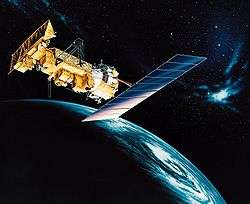ESSA-1
 ESSA 1 | |
| Mission type | Weather satellite |
|---|---|
| Operator | ESSA/NASA |
| COSPAR ID | 1966-008A |
| SATCAT № | 1982 |
| Spacecraft properties | |
| Manufacturer | RCA Astro |
| Launch mass | 304 kilograms (670 lb)[1] |
| Start of mission | |
| Launch date | 3 February 1966, 07:41:23 UTC[2] |
| Rocket | Delta C |
| Launch site | Cape Canaveral LC-17A |
| End of mission | |
| Disposal | Decommissioned |
| Deactivated | 12 June 1968[3] |
| Orbital parameters | |
| Reference system | Geocentric |
| Regime | Low Earth |
| Semi-major axis | 7,115.60 kilometers (4,421.43 mi) |
| Eccentricity | 0.0083082 |
| Perigee | 685 kilometers (426 mi) |
| Apogee | 803 kilometers (499 mi) |
| Inclination | 97.94 degrees |
| Period | 99.56 minutes |
| Epoch | 7 December 2013, 20:11:52 UTC[4] |
ESSA-1 (or OT-3) was a spin-stabilized operational meteorological satellite.
Launch
ESSA-1 was launched on 3 February 1966 at 07:41 UTC. It was launched atop a Delta rocket from Cape Canaveral, Florida. The spacecraft had a mass of 304 kilograms (670 lb) at the time of launch. ESSA-1 had an inclination of 97.91°, and an orbited the earth once every 100 minutes. Its perigee was 702 kilometers (379 nmi) and apogee was 845 kilometers (456 nmi).
ESSA-1 had a similar design to that of the TIROS satellite series. It was an 18-sided right prism, measuring 107 centimeters (42 in) across opposite corners and 56 centimeters (22 in). It had a reinforced baseplate, which carried most of the subsystems and a cover assembly (hat). ESSA-1 had approximately 10,000 1-cm by 2-cm solar cells, which charged 21 nickel–cadmium batteries. ESSA-1 was designed to take pictures of daytime cloud cover, record them and transmit them when it was in range of a ground acquisition station.
The satellite spin rate and attitude were determined primarily by a Magnetic Attitude Spin Coil (MASC). The MASC was a current Carrying coil mounted in the cover assembly. The magnetic field induced by the coil interacted with that of the Earth's magnetic field, and provided the necessary torque to maintain a desired spin rate of 9.225 revolutions per minute (rpm). Five small solid-fuel thrusters mounted on the baseplate provided a secondary means of controlling the spin rate.
ESSA-1 operated normally until 6 October 1966, when the camera system failed. The spacecraft was fully deactivated on 8 May 1967, after being left on for an additional period of time for engineering purposes.
References
- ↑ "ESSA 1". National Space Science Data Center. Retrieved 8 December 2013.
- ↑ McDowell, Jonathan. "Launch Log". Jonathan's Space Page. Retrieved 8 December 2013.
- ↑ "ESSA". NASA Science. Retrieved 8 December 2013.
- ↑ "ESSA 1 (OT-3) Satellite details 1966-008A NORAD 1982". N2YO. 7 December 2013. Retrieved 8 December 2013.
![]() This article incorporates public domain material from the National Aeronautics and Space Administration document "ESSA 1" (retrieved on 2009-03-05).
This article incorporates public domain material from the National Aeronautics and Space Administration document "ESSA 1" (retrieved on 2009-03-05).
External links
- "NASA - NSSDC - Spacecraft - Details - ESSA 1". NSSDC. May 14, 2012. Retrieved January 2013. Check date values in:
|access-date=(help) - "Tiros OT-3 spacecraft handling plan" (PDF). NASA. October 1, 1965. Retrieved January 2013. Check date values in:
|access-date=(help) - "Operational procedures for telemetry data processing for the TIROS 9 and OT-3 meteorological satellite system" (PDF). NASA. December 17, 1965. Retrieved January 2013. Check date values in:
|access-date=(help) - "Instruction and operating handbook Tiros 9 and OT-3 meteorological satellite system" (PDF). NASA. December 27, 1965. Retrieved January 2013. Check date values in:
|access-date=(help) - "Early orbit and attitude determination plan and prelaunch analysis for the satellite TIROS OT-3" (PDF). NASA. January 1, 1966. Retrieved January 2013. Check date values in:
|access-date=(help) - "Tiros OT-3 spacecraft handling plan" (PDF). NASA. January 7, 1966. Retrieved January 2013. Check date values in:
|access-date=(help) - "Alignment and calibration data for the TIROS OT-3 meteorological satellite" (PDF). NASA. January 17, 1966. Retrieved January 2013. Check date values in:
|access-date=(help) - "ESSA 1 (TIROS OT-3) Meteorological Satallite System, Vol. I" (PDF). NASA. April 20, 1966. Retrieved January 2013. Check date values in:
|access-date=(help) - L. J. Allison (May 1, 1972). "The development of hurricane Inez, 1966, as shown by satellite nighttime radiometric and daytime television coverage" (PDF). NASA. Retrieved January 2013. Check date values in:
|access-date=(help)
